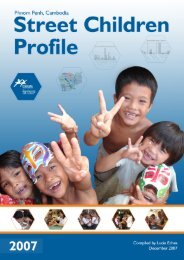Download - Friends International
Download - Friends International
Download - Friends International
Create successful ePaper yourself
Turn your PDF publications into a flip-book with our unique Google optimized e-Paper software.
years. Despite multiple factors leading to street life in Cambodia, poverty and migration<br />
appears to be the overarching reasons for why children/youth end up on the streets.<br />
In this year’s CSCN profile, poverty appears to be a more frequent reason than in the<br />
2008 survey, given the general down turn in the Cambodian economy caused by the<br />
international financial crisis. Regarding migration, unsafe patterns of migration and the<br />
depth of poverty in Cambodia consequently make the children/youth more vulnerable to<br />
trafficking and/or to end up living on the streets. The movement of the Cambodian street<br />
children/youth population is, by and large, concentrated within the country’s borders,<br />
inter-provincial and covers only short-range distances. The exception to this migration<br />
pattern is Phnom Penh, which attracts migrants from all over the country as well as from<br />
neighbouring countries. There appears to be a new group of migrants, forced migrants,<br />
caused by the extensive evictions of poor people carried out, particularly in Phnom<br />
Penh and Sihanoukville.<br />
Once on the streets, the Cambodian children/youth for the most part engage in<br />
scavenging and begging activities as to make a livelihood. Life on the streets generally<br />
impedes high risks and the main problems faced by the Cambodian street children/<br />
youth population are related to Bong Thom, violence and health issues. Surprisingly,<br />
substance abuse appears on a moderate level in the 2009 questionnaire survey, except<br />
for in Phnom Penh where 18.5 percent of the children/youth explain their situation<br />
as a consequence of drug usage. However, this result might be influenced by the<br />
stigma associated with substance abuse, thus affecting the validity of the provided<br />
answers to the question. A growing problem faced by the Cambodian street children/<br />
youth identified in all the 2009 survey locations are the clean-ups commenced by the<br />
Cambodian government placing the street children/youth in either detention centres,<br />
pre-trial detention or prisons.<br />
Compared to the results of last year’s CSCN profile, there has been a general increase in<br />
the percentage of street children/youth enrolled in primary school. Potentially reflecting<br />
the pres-sure placed on the Cambodian Government as to make progress towards<br />
achieving the UN MDG on universal primary education. However, the primary school<br />
enrolment rates of all CSCN locations are below the national average. The CSCN<br />
questionnaire survey results indicate that the main challenge regarding education of<br />
Cambodian street children/youth is to keep them in the school system once enrolled.<br />
The average education completion rate of the children/youth above the age of 6 is only<br />
2.9 years, indicating high drop-out rates considering that the average age of the street<br />
children/youth participating in the questionnaire survey being 14.3 years.<br />
CSCN<br />
118 CSCN Street Children Profile 2009






